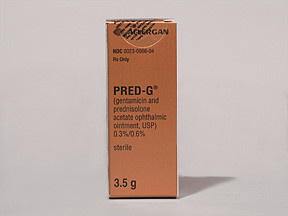GENTAMICIN/PREDNISOLONE OINTMENT - OPHTHALMIC
PHONETIC PRONUNCIATION: (jen-tuh-MY-sin/pred-NIS-oh-loan)
COMMON BRAND NAME(S): Pred-G
GENERIC NAME(S): gentamicin sulfate/prednisolone acetate
Uses
USES: This medication is used to treat conditions involving swelling (inflammation) of the eyes and to treat or prevent bacterial eye infections. This product contains gentamicin, an antibiotic that works by stopping the growth of bacteria. It also contains prednisolone, an anti-inflammatory corticosteroid that works by reducing swelling. This medication treats/prevents only bacterial eye infections. It will not work for other types of eye infections and may worsen them (e.g., infections caused by viruses, fungi, mycobacteria). Unnecessary use or overuse of any antibiotic can lead to its decreased effectiveness.
How to use GENTAMICIN/PREDNISOLONE OINTMENT - OPHTHALMIC
HOW TO USE: This medication is applied to the eye(s), usually 1 to 3 times a day or as directed by your doctor. Do not wear contact lenses while you are using this medicine. Sterilize contact lenses according to manufacturer's directions, and check with your doctor before you begin using them again. To apply the eye ointment, wash your hands first. To avoid contamination, be careful not to touch the tube tip or let it touch your eye or any other surface. Tilt your head back, look upward, and pull down the lower eyelid to make a pouch. Place a 1/2 inch (1.5 centimeters) strip of ointment into the pouch by squeezing the tube gently. Close the eye and roll the eyeball in all directions to spread the medication. Try not to blink and do not rub the eye. Repeat these steps for your other eye if so directed. Wipe the tip of the ointment tube with a clean tissue to remove extra medication before recapping it. Apply as often as directed by your doctor. If you are using another kind of eye medication (e.g., drops or ointments), apply the eye drops first and wait at least 5 minutes before applying this eye ointment. Use eye drops before eye ointments to allow the eye drops to enter the eye. If you are using another type of eye ointment, wait at least 10 minutes after using this medication before applying it. Do not use this medication more often than prescribed or for longer than 10 days unless directed by your doctor. Use this medication regularly in order to get the most benefit from it. To help you remember, use it at the same time(s) each day. Continue to use this medication for the full time prescribed, even if symptoms disappear after a few days. Stopping the medication too soon may allow bacteria to continue to grow, which may result in a return of the infection. Inform your doctor if your condition does not improve in a few days.
Side Effects
Precautions
Interactions
Overdose
Images
Reviews
Faq for GENTAMICIN/PREDNISOLONE OINTMENT - OPHTHALMIC
Gentamicin/Prednisolone ointment is an ophthalmic medication that combines an antibiotic (Gentamicin) and a corticosteroid (Prednisolone). It is used to treat certain eye infections and reduce inflammation in the eye.
Gentamicin is an antibiotic that works by killing or inhibiting the growth of bacteria causing the infection. Prednisolone, on the other hand, is a corticosteroid that helps reduce inflammation and swelling in the eye.
This ointment is commonly used to treat bacterial eye infections such as conjunctivitis (pink eye), keratitis, and blepharitis. It can also be prescribed after eye surgery to prevent or treat infections.
You should wash your hands before applying the ointment. Tilt your head back, pull the lower eyelid gently downwards, and squeeze a small amount of ointment into the space between your eyelid and eye. Close your eye for a few seconds, then blink to spread the ointment.
The frequency of use will depend on your specific condition and the instructions given by your healthcare provider. Typically, it is recommended to apply the ointment two to four times daily, or as directed by your doctor.
Common side effects include temporary blurred vision, stinging or burning sensation in the eyes, eye irritation, and increased sensitivity to light. Less common but more serious side effects may include allergic reactions, worsening of eye infections, and increased intraocular pressure. Contact your doctor if you experience any concerning side effects.
It is generally recommended to avoid wearing contact lenses while using this ointment. The ointment may contain ingredients that can build up on the lenses and cause irritation. Consult with your eye doctor for specific guidance.
Do not touch the tip of the tube to any surface to avoid contamination. Use the ointment as prescribed and complete the full course of treatment. If you experience worsening symptoms or no improvement after a few days, contact your doctor. Inform your healthcare provider about any other medications or allergies you have before using this ointment.
The use of this medication in children and pregnant/breastfeeding women should be discussed with a doctor. The potential risks and benefits need to be carefully evaluated before use.
Disclaimer
IMPORTANT: HOW TO USE THIS INFORMATION: This is a summary and does NOT have all possible information about this product. This information does not assure that this product is safe, effective, or appropriate for you. This information is not individual medical advice and does not substitute for the advice of your health care professional. Always ask your health care professional for complete information about this product and your specific health needs.

No Reviews Yet